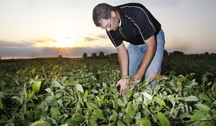August rains rejuvenate drought-stressed soybean crop
August 30, 2012
 |
|
Soybean plants typically
are waist high by the end of August, but drought limited the height of plants,
according to Shaun Casteel, an assistant professor of agronomy at Purdue.
Although these plants just west of the Purdue campus in Tippecanoe County are
only knee-high to Casteel, their height doesn’t necessarily translate into
reduced yields. Casteel, an Extension soybean specialist, is optimistic that
late-season rains could increase yield levels. (Purdue Agricultural Communication
photo/Tom Campbell) |
WEST LAFAYETTE, Ind. - July and August rains have come just in time to preserve some of the yield potential of much of Indiana's drought-stressed soybean crop, and more was on the way as the remnants of Hurricane Isaac moved north from the Gulf Coast.
While the season-long drought has not yet ended, rains and a letup in record-setting heat have combined to rejuvenate the crop so much that soybean farmers in some areas of the state could still see trend, or more normal, yields, Purdue Extension agronomist Shaun Casteel said.
But rain from Isaac over the long Labor Day holiday weekend might not be such a good thing for the crop, which could be damaged by flooded fields and wind. Rainfall amounts were forecast from 2 inches in the far north of the state to 7.5 inches in the south, according to the Indiana State Climate Office based at Purdue University.
"We could see some standing water in areas of the state that have been getting rain, where soil moisture has been replenished," Casteel said. "Soybeans in areas of the state that haven’t had much rain can still benefit from this weekend’s rain provided it is not excessive."
Most soybean plants are shorter than normal this year, so wind would not be as much of a factor as it would have been in other years. But as soybeans have recovered from drought stress, some have elongated internodes, or the distance between trifoliate leaves, and heavy pod production on the upper two-thirds of the plants. Those top-heavy plants would be most at risk for lodging, or stalk damage, from strong winds, Casteel said.
In its August crop production report, the U.S. Department of Agriculture projected that Indiana soybean yields would average 37 bushels per acre, down 24 percent from the trend prediction of 48.7. But those estimates were based on crop conditions as of Aug. 1, and if steady rainfall continues, Casteel said there's a chance growers could make up some of the difference.
"Late-July and early-August rains have helped soybeans retain pods, and more recent rains have helped the plants fill pods," Casteel said. "At this point in the growing season, we're keeping an eye on seed size."
The average size of Indiana soybean seeds is 3,000 seeds per pound. But as it rains, Casteel said that number from this year's drought-damaged crop could notch closer to 2,500 per pound.
Short plant sizes have alarmed many growers this season, but smaller plants don't necessarily equate to smaller yields.
"Plant stature isn't a driving factor in soybean yields," Casteel said. "What's more important is having plenty of leaf area. In a more normal crop, soybean plants would have 5-6 times as much leaf area as ground area, but good yields can be obtained with leaf area that is only four times the ground area."
Casteel was quick to point out that conditions vary by region. The U.S. Drought Monitor update of Thursday (Aug. 30), for example, showed that most of the improvement in conditions was in northeast Indiana, where the drought was downgraded from severe to moderate, the second level of dryness. But some counties in southeast Indiana near Cincinnati deteriorated to extreme drought, the second-highest level.
"There really have been three drought scenarios in Indiana this year," he said. "Some areas have been dry all season long, some were dry early but then had timely rains, and other areas started out with rain but dried off late."
In the southwestern portion of the state, farmers have experienced exceptional drought throughout much of the season and still might not see much potential to preserve yield at this point. In parts of the state that started out dry but then got timely rains, soybeans are progressing well. This is especially true in the north-central and the northeast. The southeast had rain early but then dried off. Pod retention has been a problem in those areas.
Growers who do have soybeans to harvest will be able to take advantage of extremely high prices. Soybean futures for November 2012 and January 2013 are hovering around $17 per bushel. That's up nearly $6 per bushel from the November 2011 futures.
With prices that high, Casteel said growers need to be doing yield estimates for grain marketing.
He also said it's important for farmers to inspect plants for bean leaf beetles. The insect emerged earlier and at higher populations after a mild winter, which gave it time to produce a second generation that could now damage soybean yields.
"We need to be out in the fields looking for bean leaf beetles feeding on pods, not leaves," he said. "Treatment thresholds are going to be lower this year because soybean prices are so high."
More information about estimating soybean yields and bean leaf beetle is available in the Aug. 24 issue of Purdue Extension's Pest and Crop Newsletter at http://extension.entm.purdue.edu/pestcrop/2012/issue22/index.html
Writer: Jennifer Stewart, 765-494-6682, jsstewar@purdue.edu
Sources: Shaun Casteel, 765-494-0895, scasteel@purdue.edu
Dev Niyogi, state climatologist, 765-49-46574, climate@ap.org
Ken Scheeringa, associate state climatologist, 765 49-48105, kens@purdue.edu
Related website:
Indiana State Climate Office: http://www.iclimate.org
Ag Communications: (765) 494-2722;
Keith Robinson, robins89@purdue.edu
Agriculture News Page

